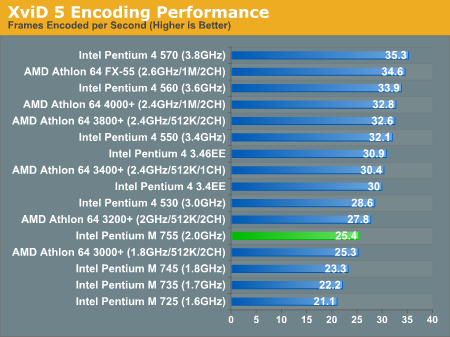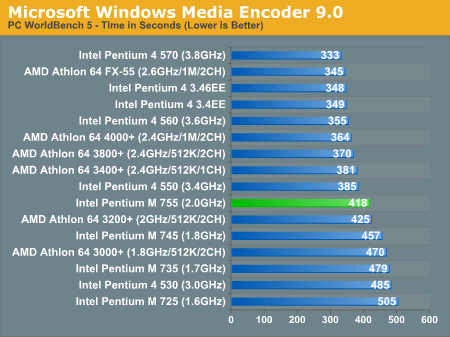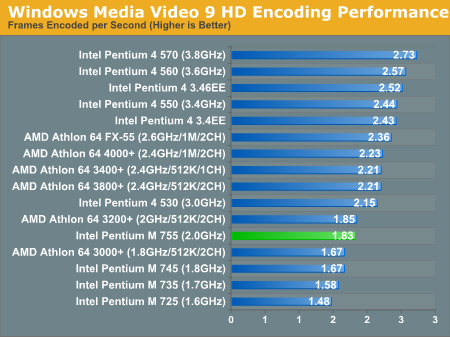Intel's Pentium M on the Desktop - A Viable Alternative?
by Anand Lal Shimpi on February 7, 2005 4:00 PM EST- Posted in
- CPUs
Audio/Video Encoding
MusicMatch Jukebox 7.10

DivX 5.2.1 with AutoGK
Armed with DivX 5.2.1 and the AutoGK front end for Gordian Knot, we took all of the processors to task at encoding a chapter out of Pirates of the Caribbean. We set AutoGK to give us 75% quality of the original DVD rip and did not encode audio.
Video encoding is very memory bandwidth and FP intensive and does not benefit much from a low latency or large cache, thus we see that all of the Pentium M's weaknesses are exploited and its performance suffers accordingly.
XviD 5 with AutoGK
Another very popular codec is the XviD codec, and so, we measured encoding performance using it instead of DivX for this next test. The rest of the variables remained the same as the DivX test.
The same results are echoed in the XviD test.
Windows Media Encoder 9
To finish up our look at Video Encoding performance, we have two tests both involving Windows Media Encoder 9. The first test is WorldBench 5's WMV9 encoding test.
Next, we have our own home-brewed HD encoding test:

To summarize - the Pentium M doesn't have what it takes when it comes to media encoding.










77 Comments
View All Comments
bobsmith1492 - Monday, February 7, 2005 - link
Granted the T8000 here is an Intel fanboy, but please notice Anand was comparing clock-for-clock.T8000 - Monday, February 7, 2005 - link
There is one big difference between this review and the reviews where the Pentium M did very well: CLOCKSPEED!While others where able to get over 2.8 Ghz with aircooling, Anand got just 2.4 Ghz. This may be a coincidence, but it is the difference between surprisingly good performance and a few % below others.
As most of the benchmarks where based on the stock 2 Ghz, the difference became even greater.
So this review just shows that the stock speed Pentium M performs about 30% less with about 30% less clockspeed than overclocked versions.
A slightly redesigned version with higher voltages is not extremely unlikely to hit at least 3 Ghz. Combining that with a desktop chipset will result in stellar performance, as the benchmark scores in this review (x1.5) indicate.
But since there is no slightly redesigned version and Intel has no good reason to make one, the current Pentium M desktops will only appeal to overclockers and silent computing people.
Also, for some reason, Anand found the 90W TDP of the 2.4 Ghz A64 closer to the 20W of the P-M than to the 110W of the 3.8 Ghz P4.
CSMR - Monday, February 7, 2005 - link
That's a very good option Zebo, thanks for posting it.teutonicknight - Monday, February 7, 2005 - link
One suggestion: Why don't you start using a newer version of Premiere for testing? I personally don't use it, but every that I know who does says before Premiere Pro, the program sucked. I'm sure the render results would be much more realistic and accurate if you used a more up to date version of the programRegs - Monday, February 7, 2005 - link
I was wondering the same thing too Jeff. If you feed it more bandwidth, it would eliminate the pipeline stalls and maybe give it a chance to reach higher clock speeds. Right? Or is it still prohibited by the shorter pipeline to reach higher clock speeds?Longer pipeline = wasted clock cycles. But to me that sounds like the PM should actually scale a lot better with a speed boost. Why exactly does it scale badly compared to a P4? Could it be remedied in anyway with a dual channel memory bus?
ozzimark - Monday, February 7, 2005 - link
there's something wrong with the 3400+ in the spec tests. why is the 3000+ beating it consitantly?Warder45 - Monday, February 7, 2005 - link
Maybe I missed something but I don't see the reason for all the negitivity in the final words. The 2.4Ghz P-M was very close to the A64 2.4Ghz in many of the tests, 3D rendering seemed to slow it down but that looked like it. With better boards and memory the P-M might best the A64 in a clock for clock match up.I do agree the prices are way too high. I think Intel really needs to wake up and smell what they have cooking here. With more support and more aggressive priceing they could easily have a winner in the HTPC and SFF markets.
plewis00 - Monday, February 7, 2005 - link
Surely when someone builds a mainboard with the Sonoma (i915) platform using PCI-E and DDR2-533 then it will change. And I wouldn't have thought that's that far off assuming they don't charge rip-off prices for the technology. It would also be perfect for Shuttle systems where the emphasis is on quietness and coolness rather than so much on performance.Zebo - Monday, February 7, 2005 - link
CSMRSo's this one very soon..
http://www.xtremesystems.org/forums/showthread.php...
...more than excellent performance wise if Dothan is excellent...power differential hopefully for AMD will be nominal.
Sokaku - Monday, February 7, 2005 - link
While it is true that the A64 has way more bandwidth, I doubt that is the reason why it crushed the P-M in the Professional Applications. I think the real cause is to be found in the P-M's abillity to do FP divisions. The P-III had a pipelined FP unit, however div operations were extremly expensive. My guess would be that Intel haven't thrown much effort into improving on this.